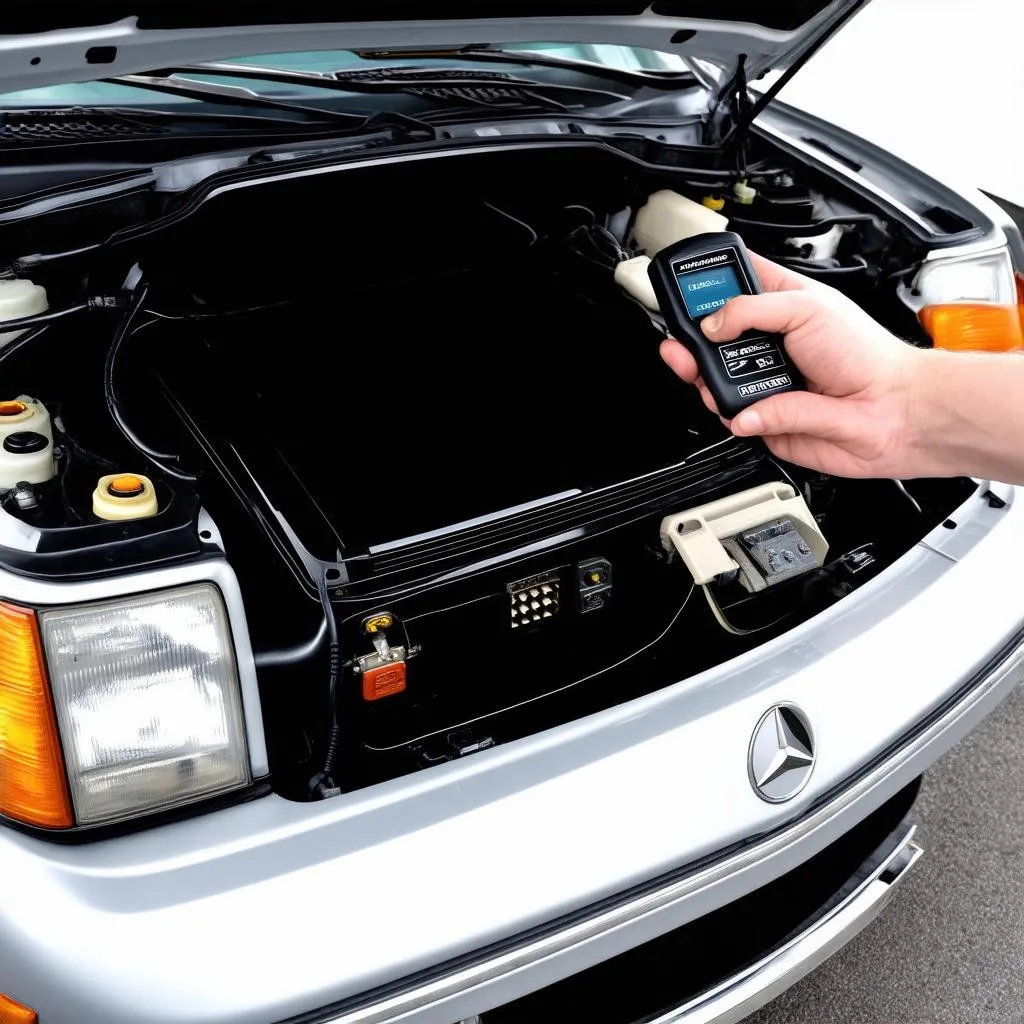Experiencing a bumpy ride in your Mercedes-Benz E-430? Worn-out front struts could be the culprit. While a complete strut replacement is the ideal solution, a temporary fix can buy you some time and save you from further car trouble. This guide will walk you through identifying faulty strut symptoms and provide a step-by-step approach to temporarily fixing them.
Understanding the Problem: Why Front Struts Matter
Front struts are crucial components of your E-430’s suspension system. They absorb shocks from bumps and dips in the road, ensuring a smooth and controlled ride. Worn struts can lead to:
- A bouncy ride: As the struts wear down, they lose their ability to dampen the car’s movement.
- Nosediving when braking: Worn struts can cause the front end of your car to dip excessively during braking.
- Uneven tire wear: Faulty struts can affect wheel alignment, leading to uneven and premature tire wear.
- Steering issues: Compromised struts can make steering less responsive and precise.
worn-car-strut|Worn Car Strut|Close-up image of a worn-out car strut, showing signs of damage and wear.
Identifying a Failing Strut: Signs to Watch For
Recognizing the symptoms of worn struts early on is key to preventing further damage to your vehicle. Here’s what to look out for:
- Visual inspection: Check your struts for any signs of physical damage, such as leaks or dents.
- The “bounce test”: Push down firmly on each corner of your car’s front end. If the car bounces more than twice after you let go, your struts may be worn.
- Listen for noises: Clunking or rattling noises, especially over bumps, can indicate worn strut components.
car-suspension-system|Car Suspension System|Detailed image of a car’s suspension system, highlighting the front struts and their connection to other components.
Gathering Your Tools and Supplies
Before starting the temporary fix, ensure you have the following:
- Jack and jack stands: To safely lift your car.
- Lug wrench: To remove the lug nuts.
- Wrench set: To loosen and tighten bolts.
- Penetrating oil: To loosen rusted or stubborn bolts.
- Strut spring compressor: A tool for compressing the coil spring (for safety reasons, renting this tool is recommended over purchasing a new one).
- Safety glasses and gloves: To protect yourself during the process.
Temporary Strut Fix: A Step-by-Step Guide
Disclaimer: This guide offers a temporary solution and should not replace a professional strut replacement. Safety is paramount, so proceed with caution and consult a certified mechanic if you’re unsure about any step.
-
Secure your vehicle: Park your E-430 on a level surface and engage the parking brake. Place wheel chocks behind the rear wheels.
-
Loosen the lug nuts: Use the lug wrench to loosen the lug nuts on the wheel with the affected strut.
-
Raise the vehicle: Position the jack at the designated jack point near the affected wheel and raise the car until the tire is off the ground. Securely support the car with jack stands.
-
Access the strut: Locate the strut assembly, which connects the wheel hub to the car frame.
-
Compress the spring (if necessary): If you need to remove the strut assembly completely, use the strut spring compressor to carefully compress the coil spring. Follow the manufacturer’s instructions for safe operation.
-
Temporary Fix Options:
-
Strut repair kit: Consider using a strut repair kit designed for temporary fixes. These kits usually include a sleeve that fits over the strut piston rod, providing additional support. Follow the kit’s instructions for installation.
-
Reinforcing the strut: If a repair kit is not available, you can try reinforcing the existing strut. This can be done by carefully wedging a piece of rubber or hard plastic between the strut mount and the body of the car. Ensure the material is securely in place and will not interfere with other suspension components.
-
-
Reassembly: Once you’ve applied your chosen temporary fix, carefully reassemble the strut assembly, ensuring all bolts are tightened to the manufacturer’s specifications. Gradually release the spring compressor if you used one.
-
Lower the vehicle: Use the jack to lower the car and tighten the lug nuts in a star pattern.
-
Test Drive: Take your E-430 for a cautious test drive to evaluate the effectiveness of the fix. Pay attention to any unusual noises or handling.
Frequently Asked Questions
Q: How long will a temporary strut fix last?
A: The lifespan of a temporary fix can vary depending on the severity of the strut damage and driving conditions. It can range from a few days to a few weeks.
Q: Is it safe to drive with a temporary strut fix?
A: While a temporary fix can restore some functionality, it’s essential to drive cautiously and avoid rough roads or aggressive driving.
Q: Can I use a universal strut repair kit on my Mercedes-Benz E-430?
A: It’s crucial to select a repair kit specifically designed for your E-430’s model year. Consult your owner’s manual or a trusted mechanic for compatible parts.
Q: Can diagnostic software identify worn struts?
A: While diagnostic tools like those offered by CARDIAGTECH are excellent for identifying electronic faults, worn struts are best diagnosed through physical inspection and observation of symptoms.
Conclusion
Addressing failing struts is vital for your Mercedes-Benz E-430’s performance and safety. While a temporary fix can offer a short-term solution, remember that it’s not a substitute for a professional strut replacement. If you notice any of the symptoms mentioned above, consult a qualified mechanic as soon as possible to discuss the best course of action for your vehicle.


